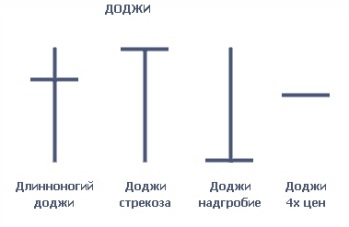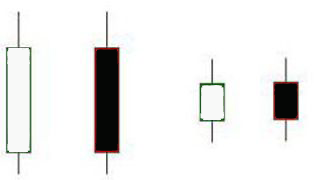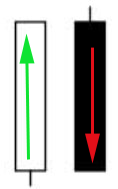Japanese Candlesticks is the best book on candlestick market analysis?
Every day more and more new market research methods appear in trading, but not all of them receive recognition from investors.
Many of the new methods cease to be used literally after a few years, without having proven their effectiveness.
At the same time, Japanese candlesticks have been around for decades and are used not only in manual analysis, but also serve as the basis for creating advisors for automated trading.
The most important issue in this case is the practical application of candlestick models and the creation of working strategies based on them.
The best source of information on which you can learn how to use Japanese candles is a book; in this article I will try to give examples of books that can be downloaded on our website.
Japanese candles.
The history of the use of Japanese candles began in the 17th century, as it is believed that the Japanese rice trader was the first to use such a tool in technical analysis, for this reason the name “Japanese candles” arose.
the Japanese rice trader was the first to use such a tool in technical analysis, for this reason the name “Japanese candles” arose.
A Japanese candlestick is a graphical figure that displays exchange rate fluctuations over a certain time period.
The main parameters that can be determined by studying a Japanese candlestick:
• Opening price - displays the quote at the beginning of the time frame , for example, on H1 from 16:00 to 17:00, the opening price will be the quote at 16:00.
• Closing price - a parameter similar to the previous one, but now displaying the quote at the end of the time frame.
Price Action - determining reversal and correction
There is a popular expression among traders: “price is the most valuable indicator.”

Displaying charts in the form of Japanese candlesticks allows every trader to experience the benefits of this approach to analytics. For example:
1. If the opening price is identical to the closing price of a graphical element, then this indicates uncertainty among large trading participants.
2. An intense surge in quotes indicates the imminent appearance of a local correction, since most likely the asset will be overbought or resold, which will provoke the opposite effect.
Subsequently, a trend may form in the direction of the price surge.
The Price Action candlestick analysis system is based on identified patterns in the behavior of currency pair charts.
Evaluating the effectiveness of the most popular candlestick patterns
Every textbook on stock trading tells us that the price chart is the very first source of information that a trader needs to look at, and only then apply any indicators and trading systems.

Indeed, many books are devoted to chart analysis, and candlestick analysis occupies a special hierarchy, since trading without the use of any trading tools is the highest aerobatics that almost all novice traders strive for.
Over time, traders have identified about three dozen different candlestick patterns, many of which actually work, and some of which ceased to show effectiveness as markets changed.
However, there are the most popular candlestick models, of which there are no more than 5 pieces.
They have become popular not because of their effectiveness, but only because they are very common and easily identified by sight.
Trend continuation candles
All those teaching textbooks on stock trading, as well as their author, unanimously tell us that trading should only be done in the direction of the trend, but not against it.
that trading should only be done in the direction of the trend, but not against it.
Indeed, trading with the trend is the most profitable activity, because if you have become in the direction of the global market movement, you do not know the psychological stress of a deposit drawdown, unlike someone who entered a position against it.
The growth of profits on your transactions will not force itself either. It would seem that everything is simple, I found a trend and entries in its direction, but in practice we all face problems.
The main problem with trading with a trend is that you do not know whether you are entering at the top and the final phase of the end of the trend or whether it will continue to move further in the same direction.
This is an age-old problem that every trader faces, because you can never say one hundred percent whether the trend will move in that direction or not.
Reversal candle combinations
The vast majority of traders never pay attention to candlestick combinations when trading. For them, Japanese candlesticks are nothing more than a display of the price that has passed over a certain period of time.
combinations when trading. For them, Japanese candlesticks are nothing more than a display of the price that has passed over a certain period of time.
However, more experienced players know that patterns can carry a lot of information about an impending storm, about the weakness of bulls and bears at a certain moment, and, strangely enough, about a possible price reversal.
There are a very large number of candlestick combinations; if my memory serves me correctly, there are more than thirty of them, and the information on how to use them does not fit even in a two hundred page textbook.
However, despite the wide variety of candlestick models, no more than ten pieces are actively used by traders, and if we talk about reversal patterns, then if five pieces are in service, then that’s good.
Candlestick combination “Three Southern Stars”.
On a candlestick chart, an important indicator is the distance between the opening price and the closing price of the time frame.
An acceleration of movement has always been considered a confirmation of an existing trend, and a slowdown in a trend always indicates its weakening.
Often during such a weakening, candlestick figures are formed, one of which is the “Three Southern Stars”.
A candlestick combination consists of three bearish Japanese candles, each subsequent one is smaller than the previous one.
The development scenario is as follows:
In a downward trend, the first to appear is a long bearish candle with a long lower shadow, while at the same time there is no upper shadow, this indicates that the price during the formation of the Japanese candle never exceeded the opening price.
Candles “Three Black Crows”
The Three Black Crows pattern is a set of three descending Japanese candlesticks. This combination is a sign of a strong downtrend and price decline.
This combination is a sign of a strong downtrend and price decline.
Interpretation of the model
The explanation of the model is that after an increasing trend, three black patterns appear; they open at or near the degree of completion of the previous day.
In reality, the model in its classical form is extremely rare, so some deviations from the rules are provided.
The form allows us to understand that this construction shows the start of extraordinary sales that have begun in the market.
Market participants close long positions, and the main trend changes its direction.
Candlestick pattern - "Grab by the Belt".
This combination of candles has many names - Yorikiri, Belt Grab, Clasp, but all of the listed models have the same appearance.
appearance.
The formation of such a combination takes place according to a rather complex scheme, so it is quite rare; one of the conditions for its appearance is the presence of a gap in the direction of the existing trend.
And the scenario itself looks like this: first, in an upward or downward trend, a fairly large price gap (gap) appears in the direction of the existing trend, after which the price immediately begins to move against the existing trend and forms a rather long candle.
Candlestick combination “Three White Soldiers”
One of the most significant for traders is the “Three White Soldiers” candlestick combination. For those expecting the emergence of an upward trend , this is an important sign.
For those expecting the emergence of an upward trend , this is an important sign.
This model often appears in the construction of currency price charts. The main signs of the appearance of which we can talk about the occurrence of this candlestick combination are a downward trend with three connected Japanese candlesticks having a long body with a direction across the main line.
All new candles open opposite the middle of the body of the past period, then the formation of the figure itself, which resembles a ladder in appearance, begins, after which the trend begins to rise.
If all candles close in the area of the highest price in a short-term period, one of the signs to strengthen the signals occurs.
Candlestick combination "Three stars".
The appearance of stars is quite difficult not to notice on the chart of the trading terminal, although such a combination of candles is quite rare and the received reversal signal requires confirmation from other sources.
rare and the received reversal signal requires confirmation from other sources.
Three stars are three Japanese Doji candles in a row, practically devoid of body and not distinguished by any particular length of shadows.
This combination can occur both in an upward and downward trend, since the Doji itself indicates the market’s indecisiveness; three Japanese candlesticks in a row only emphasize this fact.
If we consider the process of the appearance of Three Stars itself, the situation usually develops according to the following scenario.
Candlestick figure "Abandoned baby".
A rare figure with a plaintive name is a fairly strong signal for a trend reversal, especially if all the conditions for its formation are fully met.
all the conditions for its formation are fully met.
The Abandoned Baby figure consists of three Japanese candles, the first long one is a trend candle, the second one is the baby itself (doji) candlestick with a minimal body, and the third one has already formed in the direction of a new trend.
The abandoned baby can be of two types:
• The abandoned baby of the top - occurs in a downtrend, which ends with a long bearish candle, then a sharp jump in price ( gap ) follows and a doji is formed, then a price gap follows again and a bullish time frame is formed.
Bearish and bullish engulfing.
Absorption combinations can be considered one of the most powerful variants of reversal candles; this is due to the very process of forming such candle combinations. Bearish and bullish engulfing are mirror combinations and appear depending on the direction of the trend; when they are formed, the first one is a trend candle with a small body and short shadows; as a rule, it indicates a decrease in volatility on the selected time frame.
Bearish and bullish engulfing are mirror combinations and appear depending on the direction of the trend; when they are formed, the first one is a trend candle with a small body and short shadows; as a rule, it indicates a decrease in volatility on the selected time frame.
Reversal candles - "Hammer and Hangman".
These two practically indistinguishable Japanese candlesticks have long been recognized as harbingers of a reversal, although confirmation is required for a more accurate forecast.
confirmation is required for a more accurate forecast.
Hammer and Hangman - have a relatively small body and only a lower shadow, which shows how much less the minimum is than the closing or opening price, and the shadow is several times larger than the main body.
In this case, the upper shadow is completely absent, that is, the closing (opening) price is higher than the maximum on a given time frame.
The candle can be either upward or downward; the direction of the short-term trend is decisive.
Japanese star candles
By this name I no longer refer to a single candle, but to a whole combination of candles existing under certain conditions.
conditions.
The “Star” candle has a small body; when it is formed, there must be a price gap with the previous candle ( gap ).
It is this phenomenon that gives more weight to the newly formed candle.
Ideally, the price gap should exceed the shadow value, but this is not a prerequisite for identifying a Japanese candlestick.
Stars belong to candlestick reversal patterns, which only emphasizes their value; the signal is strengthened if the formed candle has a different direction of movement from the previous one.
Doji candles.
Dojis are one of the most famous combinations, either it’s in the name, or they appear quite often on the charts of currency pairs, or perhaps the reason lies in their appearance and diversity. Doji is a graphic figure in which the body is almost completely absent, this is precisely their distinctive feature. The absence of a body means that the closing price almost coincides with the opening price, that is, during this period of time the price has practically not changed.
Doji is a graphic figure in which the body is almost completely absent, this is precisely their distinctive feature. The absence of a body means that the closing price almost coincides with the opening price, that is, during this period of time the price has practically not changed.
Long and short days.
This definition of Japanese candles can be found quite often in the literature on candlestick analysis; these terms can be classified as basic, which give a general description of the formed candle.
can be classified as basic, which give a general description of the formed candle.
Long days - has a long black or white body, this fact indicates that the price has covered a fairly long distance in a day or other time period.
The main role is played by the distance between the opening price and the closing price, but the maximum (minimum) price value also does not go unnoticed.
Maribozu candles.
Japanese Maribozu candles are quite easy to spot on the chart of a currency pair, this is one of the reasons for their popularity, since the trader immediately identifies such a candle and combinations with its participation.
identifies such a candle and combinations with its participation.
Maribozu is a long candle that has no shadows, that is, its body overlaps the minimum (maximum) on a given time frame , and there are several variants of Maribozu.
Bearish and bullish Maribozu - an option in which there is no shadow both at the opening and at the close. A black candle indicates a downward trend, a white candle indicates an upward trend.
If the candle corresponds to the existing trend, then we can rather talk about its continuation than the beginning of a reversal.
Closing Maribozu candles.
This type of candle is one of the most common on candle charts; they can indicate either the continuation of a trend or be a signal for its reversal, it all depends on the appearance and combination in which it appears.
continuation of a trend or be a signal for its reversal, it all depends on the appearance and combination in which it appears.
Maribozu - translated as “Cut”, this means that the closure of this timeframe occurred at a price greater than the maximum or less than the minimum, depending on the direction of the trend.
It is clear that there are two types of Maribozu - black and white.
Japanese spinning candles.
Another type of candle that you can often notice on technical analysis charts, this candle got its unique name because of its similarity to a top.
candle got its unique name because of its similarity to a top.
Spinning tops have a relatively short body and two shadows equal and longer than the body itself.
In their appearance, they exactly resemble the top we know from childhood; thanks to their structural features, they are clearly visible on the graphs.
The shape of the candle indicates a slowdown in price movement since the rate remained virtually unchanged between the opening price and the closing price, despite some fluctuations during their formation.

